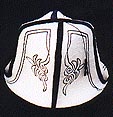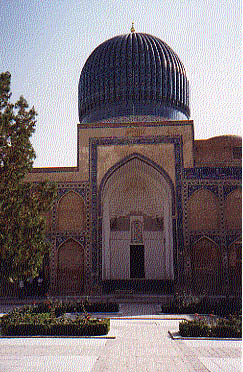Although
the distinction between the nomadic and settled people
of Central Asia and their ways of life is blurred, it
nevertheless serves as a useful framework in any consideration
of the material culture of the region. Both nomadic
and urban groups produced beautiful textiles, and other
goods, with which they dressed and ornamented themselves,
and their very different domestic and ritual environments.
(Sumner, 1999:23)
The
differences between the textiles made by nomadic and settled
people are based on:
- need
or function
- techniques
- available
materials
- motifs
and patterns.
Major
factors affecting design
Other major factors affecting design and form were the many
different cultures within Central Asia and the influence
of major cultural centres via the trade route, The Silk
Road. The Turkmen, Uzbeks, Kazakhs, Kyrgyz and Baluchi all
have a strong nomadic inheritance. Some of these groups
have settled, some are still nomadic. Some Uzbeks for example,
are currently living as nomads and others were urbanised
long ago.
Activity
Compare the following seven different cultural groups of
Central Asia presented in Table 1: Contrasting cultures.
Note the contrast in their textile arts, the fibres and
techniques they use and the manner in which skills are passed
from one generation to another.
Table
1: Contrasting cultures
| People |
Type
of textile |
Pattern,
motifs, colour |
Materials
and techniques |
|
TURKMEN
Traditionally nomads. Several subgroups: Tekke, Salor,
Chodor, Yomud, Ersari. Major and highly skilled rug
weavers. Over time many Turkmen blended with the settled
population of Turkestan, becoming skilled in agriculture
and metalwork.
Turkic
speaking.
|
Woven and felted carpets, wide range of storage bags
and trappings for tents, animal trappings.
Embroidered
dress, women's chyrpys, children's dress and
woven shawls.
|
Gul, an angular, often octagonal, motif repeated
across the field of Turkmen rugs, bag faces and trappings.
Each tribe had its own typical gul.
Ram's
horn motif.
Mainly
reds, range of shades and tones, with blues and browns.
|
Wool; silk and cotton for special pieces from local
bazaar.
Knotted
pile, flat weaves with supplementary weft patterning.
Mosaic felts. Embroidery, kesdi stitch on clothing.
Women
wove and stitched patterns from memory, hence the
use of small repeating motifs.
|
|
UZBEKS
Originally nomadic, now mostly settled. Nomadic Lakai
Uzbeks highly skilled in fine embroidery.
Turkic
speaking.
|
Woven, felted and embroidered carpets. Wide range of
embroidered bags, purses, belts, tent ornaments and
animal trappings. |
Pattern variety resulting from disparate historical
and cultural influences. Islam also major influence
on urban design, suzanis mainly floral.
Geometric
and curvilinear patterns in nomadic embroideries.
Ram's horn, hooked sun disc motifs common.
More
yellow used than in other groups.
|
Silk, cotton; wool from trade in towns, or own wool
in nomadic groups.
Ikat
silks made by men in urban workshops; dowry embroideries
(suzanis) made by women at home.
Pile
weave, flat weave, felted and embroidered carpets;
range of counted thread and freestyle embroidery stitches.
|
|
KAZAKHS
Largest group of nomads who still live in yurts.
Russian
incursions and influence disrupted traditional tribal
structure. Kazakhs became more dependent on trade
goods and produced fewer traditional textiles.
Turkic
speaking.
|
Woven rugs, saddle bags and tent trappings. Felted
carpets.
Chii
(wool-wrapped reed screens) for tent.
Embroidered
tent trappings, especially tuskiiz (decorative
hangings) and costume.
|
Curvilinear and floral motifs. Ancient ram's horn
motif from nomadic heritage dating back to at least
500 BC, when Pazyryk carpet was woven.
New
bright colours when aniline dyes introduced.
|
Wool; silk and cotton obtained via trade, bought.
Pile
weave and flat weave carpets. Felting in mosaic and
overlay techniques.
Range
of embroidery stitches, especially chain and satin
stitch.
|
|
KYRGYZ
Once predominantly nomadic, many now settled or semi-settled.
Turkic
speaking
|
Woven and felted carpets.
Chii
(wool-wrapped reed screens) for tent.
Embroidered
tent trappings, especially tuskiiz (decorative
hangings) and costume.
|
Designs similar to Kazakh style. Curling ram's horn
motif common. Chinese and Russian influences also
evident.
Bichromate
palette, equal balance of two colours, often red and
blue, or blue and brown, in felts.
|
Wool; silk and cotton obtained via trade, bought.
Pile
weave and flat weave carpets. Felting in mosaic and
overlay techniques. Flat weave strips, joined for
larger pieces. Embroidered felted hats are worn by
the men.

Range
of embroidery stitches, especially chain and satin
stitch.
|
|
TAJIKS
Oldest settled population in Central Asia. Blended
with urban Uzbeks over time, city dwellers called
Sarts.
Persian
speaking.
|
Wall hangings and clothes for men, women and children
of ikat patterned silks.
Embroidered
wall hangings, bed coverings, suzanis.
|
Blending of cultural influences in towns and villages.
Relationship to nomadic heritage, rug patterns in
ikats.
Floral
and cosmological motifs in suzanis.
Major
Islamic influence on design; winding leafy stems,
absence of humans and animals, never-ending patterns.
|
Silk, cotton grown locally; wool by trade with nomads.
Silk,
silk and cotton ikats, made by master dyers and weavers
in urban workshops.
Dowry
embroideries (suzanis) made by women at home;
chain stitch and basma (couching).
|
|
BALUCH
Mainly nomadic, Iran, Afghanistan and Pakistan.
Now
divided into subgroups.
|
Utilitarian pile and flat weave carpets, small rugs,
mats and donkey bags.
Embroidered
dress in northern Pakistan.
|
Fine patterns, sometimes taken from neighbouring tribes,
tree of life in prayer rugs. Often ornamented with
shells, bone and glass beads.
Predominantly
blue and rust red, brown. White and polychrome accents.
|
Wool, silk from town bazaar for accents. Silk embroidery
on dress.
Knotted
pile and flat weaves.
|
|
ARABS
Settled people, sheep and farming. Nomadic when the
need arose.
Brought
Islam in the early 8th century.
|
Large flat-weave rugs.
Julkhirs,
long-pile carpets resembling animal pelts.
|
Large geometric blocks of colour. Calligraphy added
as ornament to geometric, abstract and floral motifs.
Blue,
red, orange, brown, ivory.
|
Mainly wool, some cotton.
Kilims
using both slit and dovetail tapestry.
|
|
Religion
The strongest religious influences in Central Asia
were Buddhism and Islam. Buddhism came to Central
Asia from India via the Silk Road and then travelled
to China and Japan. The significance of Buddhism decreased
in Central Asia when the Arabs brought Islam to the
region in the early 700s. This was reinforced by Ghengis
Khan and Timur in the 13th and 14th centuries. Islamic
influence is evident in the beautiful tile work on
madrasehs and mosques. Much of this decoration
is also reflected in the textile arts of both nomadic
peoples and oasis dwellers.
Islamic
design
Islamic pattern is characterised by an abstract, floral
and leafy ornament, repetition and unending pattern.
This relates to the idea that Allah is in everything
and is everywhere and the only one who could create
life. Also Islamic artists were prohibited from representing
living beings, in case people regarded them as objects
of worship. Where people and animals were represented,
for example in nomadic rugs and animal trappings,
they were often highly abstracted. This resulted in
very geometric flowers, people or animals.
|
 Photo:
Christina Sumner
Photo:
Christina Sumner |
Shamanistic
beliefs
As well as these two religions the nomadic people were influenced
by their shamanistic beliefs (belief in the supernatural).
This included rituals designed to ensure a good season or
good luck. This was achieved, they believed, by appealing
to the dead, natural forces or the tribe's totemic animal.
Men
and women – varying roles
Traditionally,
women in the nomad tribes were allowed much greater
freedom and communal responsibility than women in the
Islamic oasis cities. Yurts and their furnishings are
not only made by the women, but are also owned and transported
by them. Men are often responsible for shearing and
dyeing the wool and other yarns, but the women are the
felt makers and weavers. The family as a whole benefits
from the sale of surplus textiles, and the Turkmen women
were and are renowned for the beauty of their carpets.
However, in the Islamic cities, women were not permitted
any life outside their homes (and even in their homes
were often restricted to the women's courts). Felts
and carpets were made by men in small-scale workshops
in both villages and cities, while women's great art
was that of embroidery for both costume, and wall and
bedding textiles. (Sumner, 1999:13)
Among
settled peoples,
Women
were responsible for the rearing of the silkworms and
they wove the cotton fabrics that were widely distributed
for both home use and export, while men were responsible
for producing silk fabrics. (Sumner, 1999:29)
Activity
Compare the roles of men and women in the production of
textiles in nomadic and urban lifestyles. Some examples
are provided.
|